The Manchester Derby is one of the world’s biggest derbies – the match between historic heavyweights Manchester United and newly enriched Manchester City has not only decided the English Premier League but also has given fans a great game of football to enjoy.
With the title being anchored at Anfield with every passing day, this match presented the Citizens a chance to lessen the gap between themselves and Liverpool and truly challenge the Reds to an EPL title.
On the other hand, a poor start for Solskjær’s Red Devils has seen them being near the midtable of the Premier League. This win would continue their recent string of impressive runs, as seen by the victory against Tottenham Hotspur, and potentially climb to fifth place. With the Top Four separating from the pack, this was the Red Devils’ opportunity to get a climb on their opponents and get closer to the top.
In this tactical analysis, we will discuss the tactics used by Manchester City and Manchester United. We will have an analysis of how Solskjær was able to beat Guardiola in the Derby.
Lineups
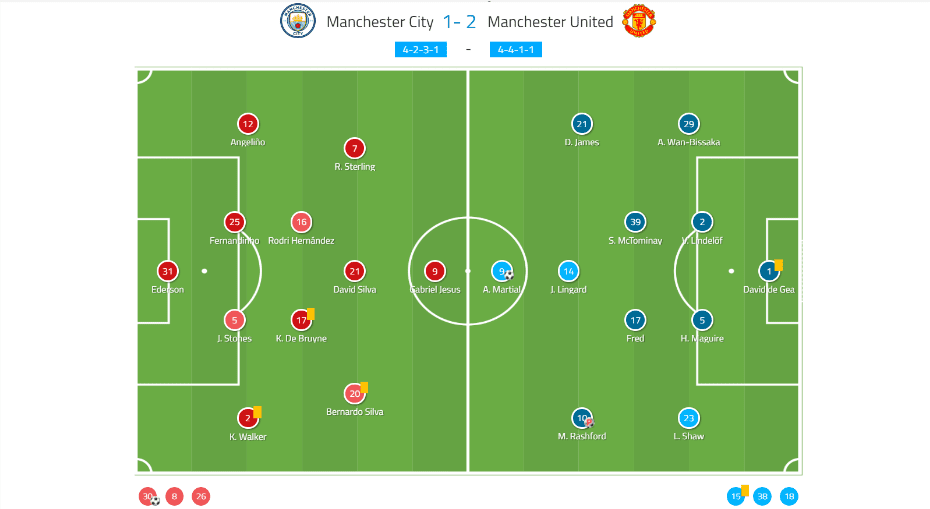
Pep Guardiola only made one change to his team that beat Burnley 4-1: defender Nicolás Otamendi was replaced by Englishman John Stones.
On the red side of Manchester, Ole Gunnar Solskjær only made one change as well: forward, and youngster, Mason Greenwood was replaced by the forward Anthony Martial.
United’s defensive structure sets them up for counter-attacking success
Right from the get-go, it was clear that the Red Devils were not looking to best the Cityzens at their own game. Assuming a fluid 4-2-3-1 / 4-4-1-1, the Red Devils were looking to patiently defend and counter-attack City.
This counterattacking approach is gleaned from PPDA, a statistic that stands for passes allowed per defensive action and allows us to measure defensive and pressure intensity. In essence, it allows us to measure the pressure that the defending team puts on the opposition when they are in possession of the ball.
A higher PPDA means that the team allows many passes to occur when it is defending while a lower PPDA means that the team is allowing fewer passes and therefore being more attacking-minded.
The Sky Blues, during the whole match, had a PPDA of 4.2 while the Red Devils had a PPDA of 26.1. Clearly, United wanted City to play into their half more so they could find a misplaced pass and attack City’s disjointed formation.
By definition, if you are counter-attacking, you will cede the possession to the opponent. As such, the defensive structure has to be important so that you can withstand the number of attacks that will be created from this greater possession.
So how exactly did United defend off the ball?
The first key lies in their use of a pivot.
The pair of Fred and Scott McTominay formed a considerable pivot that lay just ahead of the back four to give the Red Devils extra protection. In terms of profile, both Fred and McTominay like to get physical and be aggressive – a facet that would come into use.
One of the ways City attacks is by positioning key midfielders in the halfspaces as to allow for quick crosses. Since these players are already positioned on the half-turn – when your body is open to one side at an angle – they are able to quickly wrap their feet and cross or look for the penetrative pass inwards.
In this game, these midfielders were Kevin De Bruyne and David Silva – two technicians that have immaculate ability on the ball. Controlling these midfielders would help United control City’s half-space attacks and as such, narrow City’s attacks to certain areas.
Both Fred and McTominay were instructed to man-mark both de Bruyne and Silva. This man-marking restricted the freedom of these two midfielders and as such, making lay-offs and combination play became difficult as Fred and McTominay would consistently clip at behind their back or quickly come in front to block the passing lane.
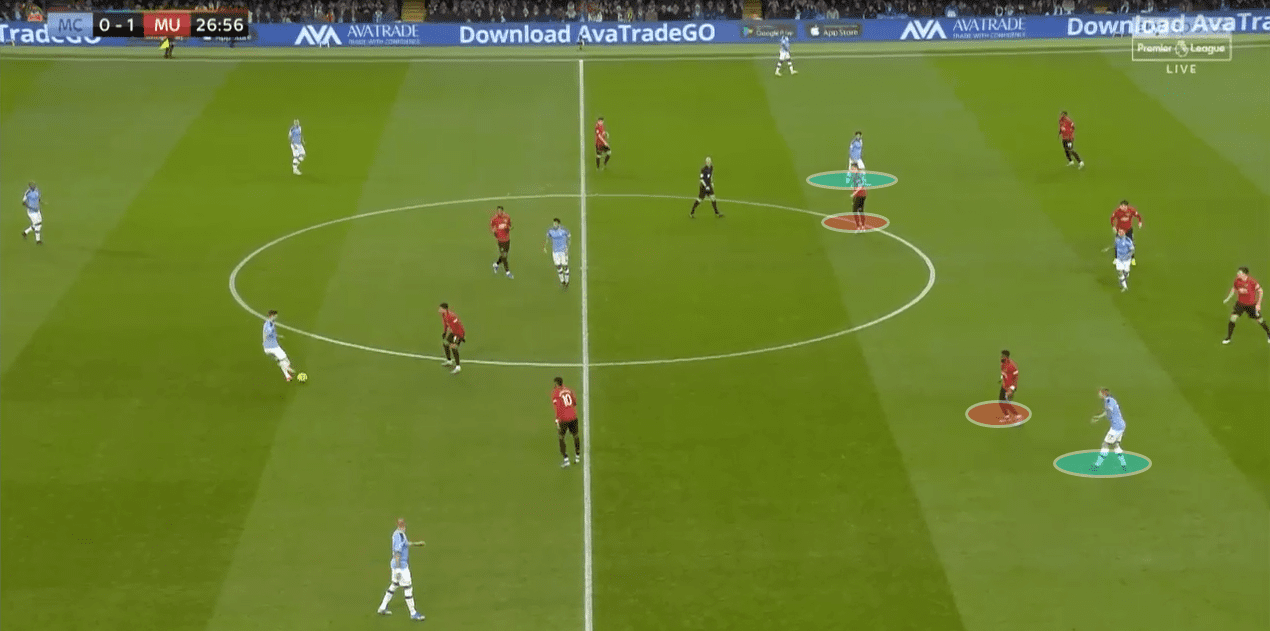
In this picture, we see Fred and McTominay man-marking de Bruyne and D. Silva respectively. As such, here, City have no route of playing into their more playmaking midfielders – an aspect which starves them of creativity and forces them to look outwards.
This man-marking had another benefit: it allowed United to control intricate play on the wings.
City position their wingers very wide on the touchline. The line of reasoning is to have the full-backs – who often come into the midfield – and the half-space midfielder to overload space inside. This creates space on the wings and allows the winger to express himself to the greatest extent.
With the half-space midfielder being man-marked, it allowed the full-backs to come up and get very close to the wingers. As such, combination play down the wings was very limited as the winger and the half-space midfielder were now being watched.
This made it very difficult for City to progress through and often led to the ball being played back.
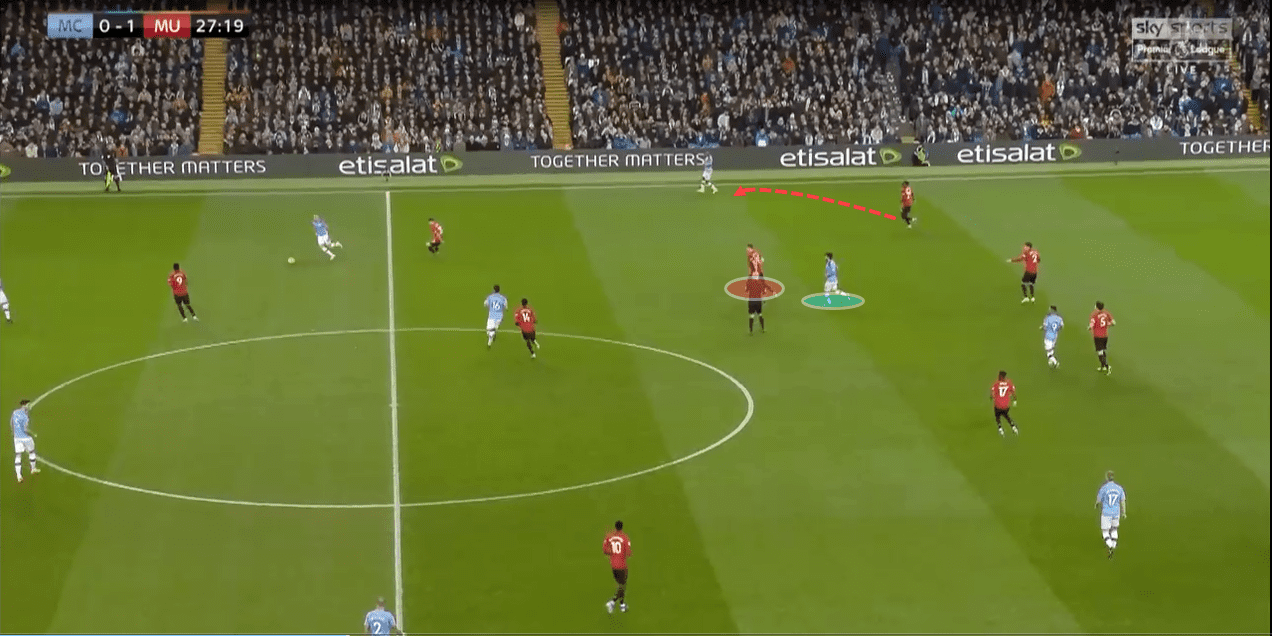
In this picture, we see McTominay man-mark D. Silva. Knowing the interior midfielder is being defended against, Aaron Wan-Bissaka knows that he is free to drift to the wing and get close to Raheem Sterling. Here, he starts making initial movements in case a chipped ball from City’s defence is played to Sterling.
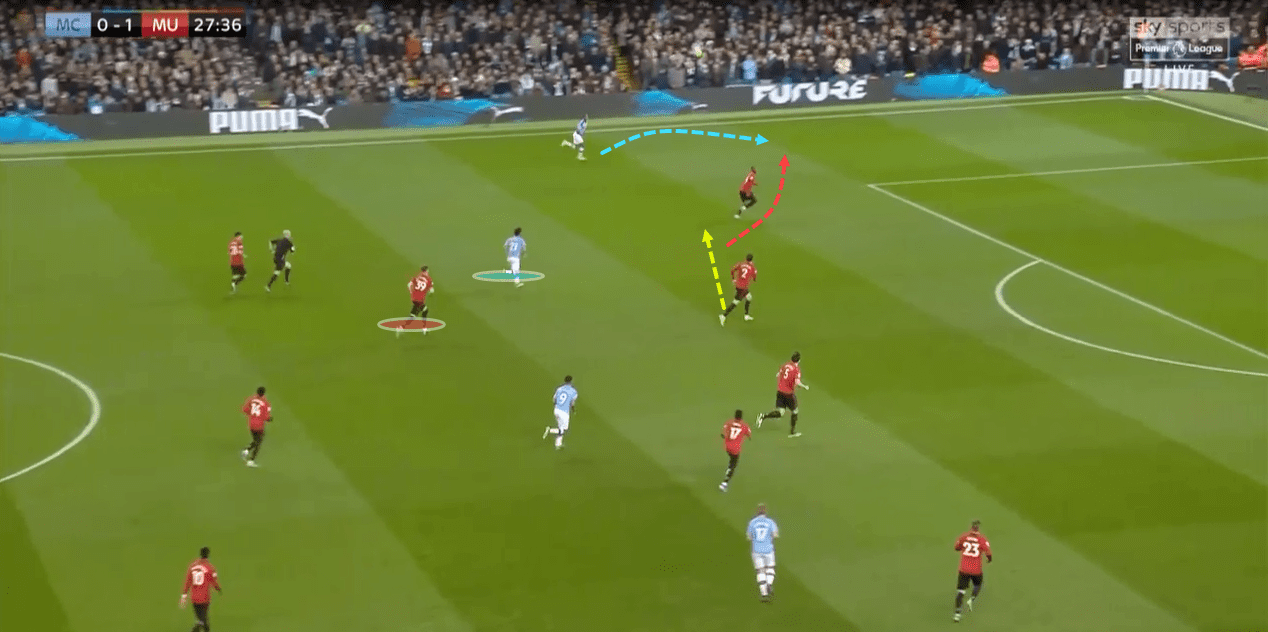
Here we see the defensive tactics working. McTominay presides a little distance over D. Silva which means that Wan-Bissaka is free to leave his right-back position and directly challenge Sterling. Note that because of this man-marking, nearby defender Victor Lindelöf can step in and create a 2v1 situation if Wan-Bissaka is not able to handle Sterling.
Situations like these could only be created by this use of the pivot, underlaying its importance in United’s defensive structure.
The final key was how the attacking quartet of the Red Devils pressed. United’s defensive tactics ensured that de Bruyne and D. Silva were limited which in turn limited the number of touches for Bernardo Silva and Raheem Sterling.
The attacking quartet ensured that the City defensive players never got settled in a comfortable position so they could dictate their play. Jesse Lingard keep a man-mark on central defensive midfielder on Rodri while Marcus Rashford and Daniel James would press the full-backs – who would often come into the middle.
This meant that City were forced to always switch on the sides and never got the chance to play through the middle.
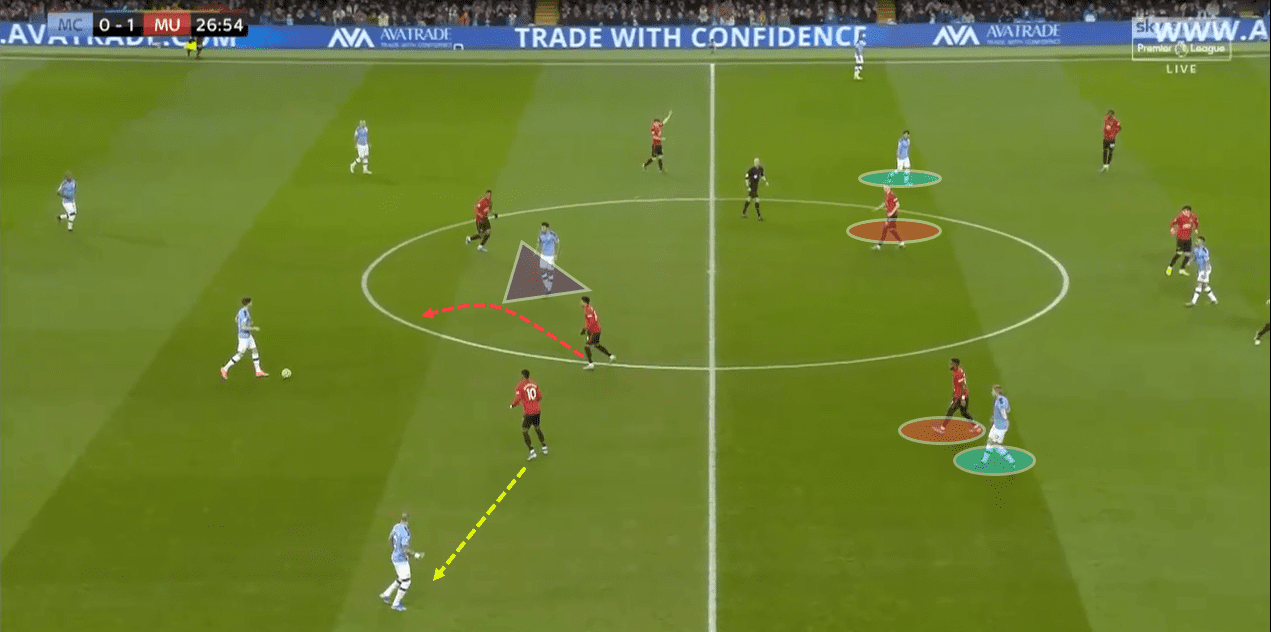
Here we see all components of United’s defensive structure working. The man-marking from the pivot closes passing options to D.Silva and de Bruyne. Nearby, Lingard applies the pressure to the ball-carrier in a curved run – therefore taking out the passing option to Rodri.
Finally, Rashford adjusts his positioning to get closer to Kyle Walker and get close to him as the ball is played to the wide. On the other side, James, the one with the raised hand, occupies the right-hand halfspace to prevent City players from playing through the middle.
All in all, City have very few options to play down to and as such, will try riskier plays to break this monopoly which results in misplaced or poorly hit passes and dispossessions.
With the frequency of these being created, United now had a real chance to counter-attack.
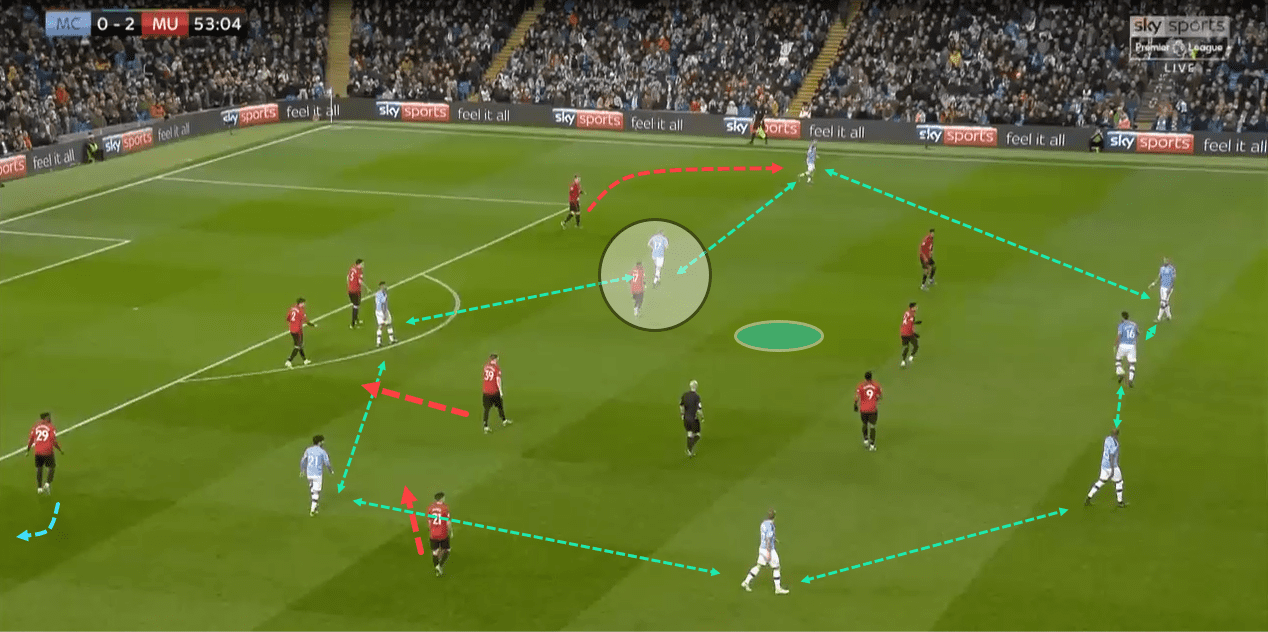
In this picture, the passing lanes to City players in the midfield are easily able to be intercepted and if that doesn’t work, the recipients of the ball, such as de Bruyne, are man-marked such that dispossession can occur.
This structure from United invites City to play riskier passes which plays into United’s gameplan of forcing mistakes from the Cityzens. To avoid this, the Sky Blues will resort to playing to the wingers but due to the pivot’s man-marking, the full-backs can split and control the wingers
This is evidently seen in the number of losses of the ball by Manchester City. The Belgian maestro lost the ball 21 times while D. Silva lost possession 15. These two players rank the highest in dispossession and it should be no surprise because of the pivot’s defensive man-marking as talked about before.
In total, the Cityzens lost the ball 105 times during the match – enough opportunities for United to quickly regain possession and counter-attack. Moreover, out of these 105 dispossessions, City lost 24 with their passes. Alarmingly, the ball was lost 38 times due to ground duels – a function of United’s strong man-marking and pressing.
City’s inefficient possession structure leads to a failure in the attack
As effective was United’s defensive structure, they still opened up holes in their formation from time to time. However, City’s inefficient possession structure meant that they were unable to take advantage of these gaps.
A possession structure is simply how a team sets up their players when they have the ball. Certain positionings allow the team to find and exploit spaces easier than compared to other positions.
However, City’s inefficiency in their possession meant that their attack suffered.
Through the whole game, City created an xG of 2.42 while United managed an xG of 1.68. However, even a high xG, an xG higher than their opponent, City only managed one goal.
City had an xG of 1.43 in the first half – with the main contributor being forward Gabriel Jesus. However, in the second half, that dropped to an xG of 0.98 with the main contribution coming from defender Otamendi.
When a majority of your attack in a half stems from your defender, there are some structural issues in the attack.
The first problem involved an over-reliance on certain players and patterns: mainly Sterling and de Bruyne. The two highest players passed to, in the attack, were Sterling (55 passes) and de Bruyne (72 passes).
Despite the impressive talent in City’s squad, only two players were important in the attack – acting as the fulcrum for attacking movements. This reliance on these two players was not complemented by other movements as we’ll see later on.
Having seen United’s defensive rigidity, these two players were already limited in their movements. Playing into these two players diminished City’s attacking prowess even further as these limited players had little they could do with such man-marking.
The second problem involved the use of inverted full-backs. They’ve been referenced many times in this analysis and for good reason. Initially, these inverted full-backs were the next progression in tactical evolution. However, this game gleaned out the flaws with these full-backs.
Having an inverted full-back – a full-back that comes into the middle – reduces the width of the play and thereby constricts the play inwards. While this is good when City are able to attack through the middle, it back-fired on Guardiola’s troops. City played in a width of 43 meters, this width being narrower to United’s 52 meters.
In particular, the positioning of Kyle Walker was a problem, for City, attacking wise. His inverted positioning meant that he occupied the same channel as winger B. Silva. As such, if City wanted to switch the play to the other side, they had to do it via Walker as he impeded the passing lane to the Portuguese winger.
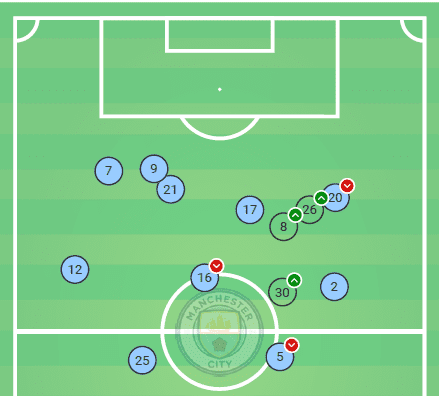
In this picture, we see that Walker, shown in 2, is in the same channel as B. Silva, 20. This creates a dilemma as two players occupy the same channel and plays can’t happen as fluidly and quickly as possible.
Moreover, Walker is not as technically creative. This came to hurt City as there were times where United opened the wing channel or the half-space channel. However, the profile of Walker meant that he was not able to make those forward passes and as a result, passed backward.
For a full-back that was close to de Bruyne and B. Silva, Walker only played seven pass combinations with de Bruyne and six pass combinations with the Portuguese Silva.
This limited play meant that not much attack was able to occur on the right-hand side with the trio of de Bruyne, B. Silva, and Walker not able to play intricate and construct creative plays. B. Silva, who normally is very involved, only recorded an xG of 0.23.
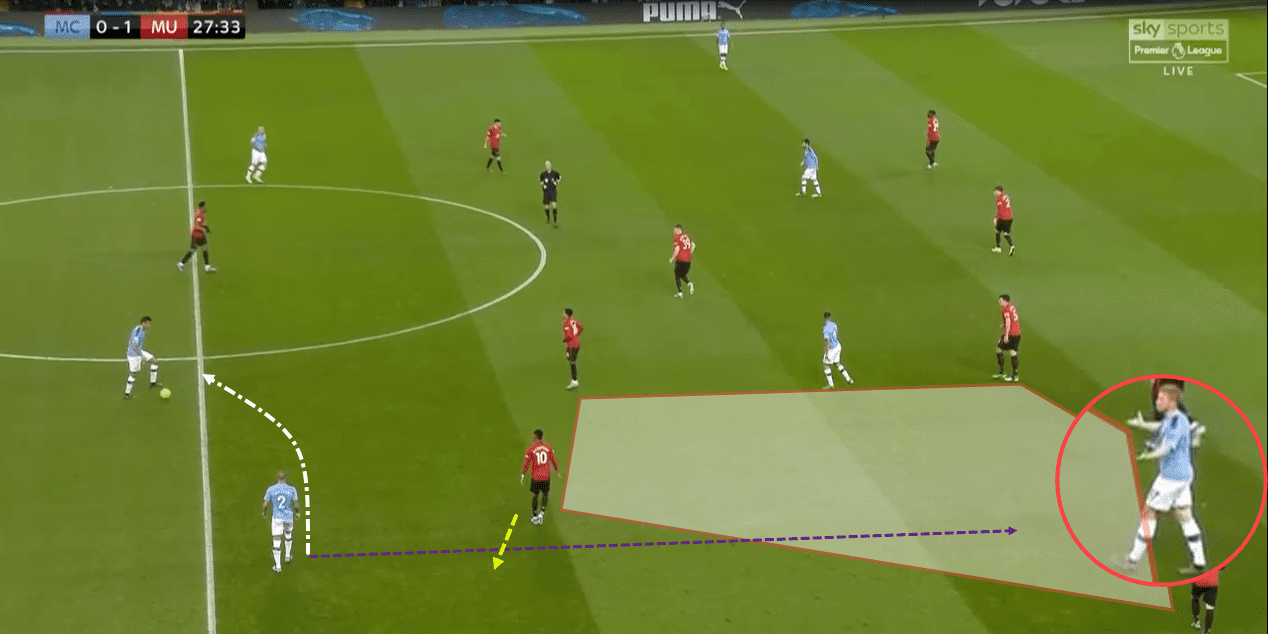
Here United have created a gap in their defence and Walker, instead of exploiting it, passes it to Rodri. You can see de Bruyne’s frustration as he signals to Walker to pass it to him and angrily reacts to not having the ball.
A good technical player would have passed but due to Walker’s lower skill-set, there is a fear that Rashford can intercept the pass and the threat of counter-attack would remain. As such, he plays it safe which prevents a potential City attack.
On the left-hand flank, the prime tactic seemed to be pass to Sterling. Looking at the pass combinations, the strongest one in the whole team, was the pass from Fernandinho to Angeliño to Sterling. This relatively basic passing play on the left-hand side left much to be desired.
While Sterling did get chances to go one on one against, which what he did the whole game, he was cast into situations where United numerically beat him. As such, Sterling’s impact was very limited. The prolific Englishman was reduced to an xG of 0.02.
As such, City’s main threat came from Jesus and D. Silva whose close play and positioning meant that they were able to glean out high xGs for the pair of them while also getting a decent amount of shots.
The Brazilian forward recorded the highest xG, 0.64, while the Spaniard midfielder recorded an xG of 0.43. However, in those scenarios, the formidable David de Gea made sure that these chances did not find their back in the net.
One aspect of City’s plays that helped de Gea were what City’s attacks transformed as the game went on. Slowly and slowly, City’s only play ideas only seemed to be crossing and crossing.
The Sky Blues recorded an astounding 43 crosses with only eleven of them actually being accurate. As such, the United defence had easy pickings and could easily control the aggression of City.
United’s dangerous trident spells danger
As good as was United’s defensive structure, their counter-attacks were even more impressive.
The main component of United’s counter-attacks was pace – and for good reason.
The back-line of City was Stones, Fernandinho, Walker, and Angeliño. Two of the defenders, Fernandinho and Walker, are ageing and are not the younger and faster versions they once were. Two of the rest, Stones and Angeliño, had relative new experience playing in the first-team squad and as such, they had not strengthened their defensive awareness.
As such, you had a makeshift City backline that put on a facade of defensive rigidity but it really was one knock from crumbling down.
Solskjær knew this and recognized that he had the perfect trident to spear the Blue Fish. The trio of Rashford, James, and Martial are all fast forwards. Moreover, they are all young making them perfect candidates to just run with and without the ball.
Combine their searing pace with tactical intelligence and you have strong trident to spear even the biggest of fishes.
United’s counterattacks were set in certain ways to maximize space creation.
The first was whenever United counterattacked, they allowed Martial free reign of movement. As such, various times during counter-attacks, Martial moved from this traditional striker role. The most common position for him was to move to the right, near James.
This created trouble for the City defence as the defenders were often hesitant to follow Martial. This hesitation, combined with ageing defenders and weak defensive relationships from the Cityzens, meant that Martial was able to create gaps in City’s defence.
This right-ward movement of Martial overload the right-hand side which created space in the middle for the likes of Rashford and trailing midfielder Lingard. With Rashford leaving his left-ward position and Lingard coming central, City were left short-handed in the middle which allowed the Red Devils to get plenty of testing shots and high-scoring chances.
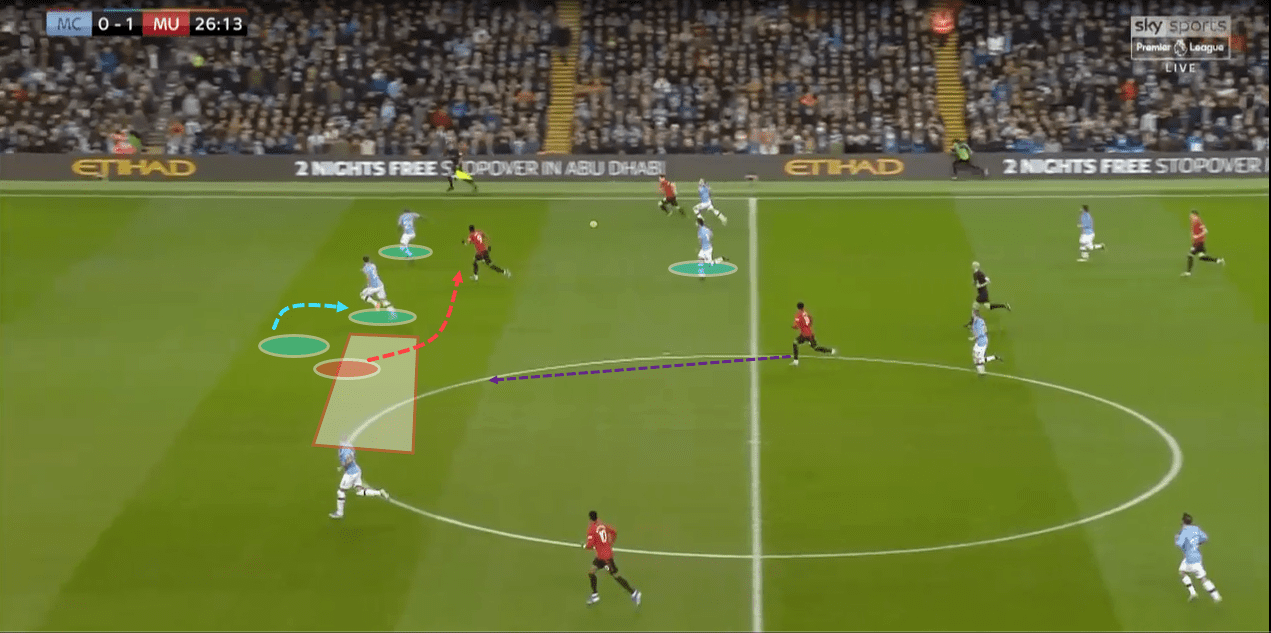
Here Martial moves from his central positioning in a curved run. Consequently, the central defender also shifts from the centre. These shifts create space in the centre which is exploited by the trailing Lingard. He can make a straight run, taking advantage of the space and potentially going 1v1 against the goalkeeper.
Another tactic was to play crossfield passes.
Whenever United got hold of possession and started counterattacking, they would always look to play crossfield. This tactic took advantage of the wide positionings of James and Rashford and allowed Solskjær’s men to stretch the Cityzens’ defence left and right.
This was yet another method to creating space. Combine these passes, United’s pace, Martial’s tactics, and a make-shift defence and United always had a goal-scoring counter-attack on the ready every time City lost the ball.
Conclusion
This week has undoubtedly been a historic week for Solskjær. He has defeated two of the world’s best managers in Mourinho and Guardiola. As this analysis has shown, the Norweigian legend has a few aces up his sleeves and if teams aren’t careful, those aces will transform into goals.
On the blue side of Manchester, although fans will argue that this shade of blue is actually red, Guardiola’s title push seems to be coming to a close. A remarkable fourteen point gap between them and the Champions League winners at Melwood Road means that the blue-tinted title is finally showing its true colours.
As another exciting match comes to a close, the possibility of Liverpool (finally) winning a title becomes a more inevitable prospect. But, if the Premier Leauge has taught us anything, it has been to expect the unexpected.

If you love tactical analysis, then you’ll love the digital magazines from totalfootballanalysis.com – a guaranteed 100+ pages of pure tactical analysis covering topics from the Premier League, Serie A, La Liga, Bundesliga and many, many more. Buy your copy of the December issue for just ₤4.99 here





Comments